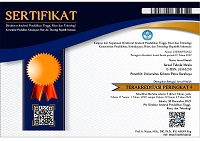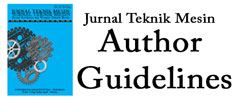Pengembangan Proses Produksi Biodiesel Biji Karet Metode Non-Katalis Superheated Methanol pada Tekanan Atmosfir
Keywords:
rubber seeds, biodiesel, non-catalyst, superheated metanol, bubble column reactor.Abstract
The process of biodiesel production from rubber seed (hevea brasiliensis) is conducted in Indonesia in general using catalyst (acid or alkaline) and wet washing method or dry washing method. Catalyst method brings many weaknesses include: a long production time, high production costs due to wear or magnesol as a catalyst absorban, especially if the purification uses water (wet wash system) because it will be harmful to engine components such as: seal leaks quickly, easily arise fungus, rust/corrosion on the cylinder heads, pumps and fuel filters are often clogged, etc. Biodiesel production process with non-catalytic method can overcome the weaknesses mentioned above. In this study, rubber seed oil is obtained by the method of pressing.The oil specifications are as follow: viscosity 5.19 cSt, density 0.9209 g/ml, water content 0.2%, free fatty acid (FFA) 6.66%, and the boiling point 305 oC.The methodology used is processing rubber seed into biodiesel with superheated methanol non-catalyst method. Transesterification performed in a Bubble Column Reactor (BCR) at the reaction temperature 270oC, 275oC, 280oC, 285oC, and 290 oC and held at atmospheric pressure. The molar ratio of methanol and rubber seed oil were: 140, 150, and 160. The results showed that the process of making biodiesel from vegetable oil catalyst method is usually carried out through the various stages of the process e.g: degumming process to remove mucus or sap it contains, esterification to reduce the FFA content to below 2,5% to prevent saponification, and tranesterification to obtain methyl esters or biodiesel and then washing. But in its development by using non-catalytic method turns out that the rubber seed oil has a high FFA content (above 2.5%) can be directly processed tranesterification without any saponification formed and can produce biodiesel without having to experience the process of degumming, esterification and washing. The density, cetane number, pour point, flash point, and the acid number of non-catalyst method is better than the catalyst method.The disadvantage is that micro carbon residue contained by biodiesel of rubber seed oils (B-100) are still high enough above the allowable standard. The optimum methyl ester content was obtained at molar ratio of 160 and the reaction temperature 290 oC because it produces the largest biodiesel and the smallest glycerol. Abstract in Bahasa Indonesia: Proses produksi biodiesel dari biji karet (Hevea brasiliensis) yang dilaksanakan di Indonesia pada umumnya memakai metode katalis (asam atau alkil) dan metode pencucian basah atau metode pencucian kering. Metode katalis membawa banyak kerugian antara lain: waktu produksi lama, biaya produksi tinggi karena menggunakan magnesol sebagai absorban, terutama jika pemurniannya menggunakan air (sistem pencucian basah) karena akan dapat merusak komponen mesin seperti misalnya: seal cepat bocor, mudah timbul jamur, karat / korosi pada silinder head, pompa dan saringan bahan bakar sering buntu, dan sebagainya. Proses produksi biodiesel dengan metode non-katalis dapat mengatasi kelemahan seperti disebutkan di atas. Pada studi ini, minyak biji karet diperoleh dengan metode pengepresan. Spesifikasi minyak adalah sebagai berikut: viskositas 5,19 cSt, densitas 0,9209 g/ml, kandungan air 0,2%, asam lemak bebas (FFA) 6,66%, dan titik didih 305oC. Metodelogi yang digunakan adalah pemrosesan biji karet menjadi biodiesel metode non-katalis superheated methanol. Tranesterifikasi berlangsung di dalam sebuah Bubble Column Reactor (BCR) pada temperatur reaksi 270oC, 275oC, 280oC, 285oC, dan 290oC serta pada tekanan atmosfir. Rasio molar antara methanol dan minyak biji karet adalah: 140, 150, dan 160. Hasil penelitian menunjukkan bahwa pada proses pembuatan biodiesel dari minyak nabati metode katalis biasanya melalui berbagai tahapan proses yaitu: proses degumming untuk melepaskan getah atau lendir yang dikandungnya, esterifikasi untuk menurunkan kadar FFA sampai di bawah 2,5% untuk mencegah penyabunan, dan tranesterifikasi untuk memperoleh metil ester atau biodiesel dan kemudian pencucian. Tetapi dalam pengembangannya menggunakan metode non-katalis ternyata bahwa minyak biji karet yang memiliki kadar FFA tinggi (di atas 2,5%) dapat secara langsung diproses tranesterifikasi tanpa terjadi penyabunan dan dapat menghasilkan biodiesel tanpa harus mengalami proses pendahuluan degumming, esterifikasi, maupun pencucian. Densitas, angka setana, titik tuang, titik nyala, dan angka asam metode non-katalis lebih baik dari pada metode katalis. Kelemahannya adalah bahwa residu karbon mikro yang dikandung oleh biodiesel minyak biji karet (B-100) masih cukup tinggi di atas standar yang diijinkan. Kadar metil ester optimum diperoleh pada rasio molar 160 dan temperatur reaksi 290oC karena menghasilkan biodiesel terbesar dan gliserol terkecil Kata kunci: biji karet, biodiesel, non-katalis, superheated methanol, bubble column reactor.Downloads
Published
2010-06-18
Issue
Section
Articles
License
Jurnal Teknik Mesin diterbitkan oleh Universitas Kristen Petra.
![]()
Artikel dan semua materi yang diterbitkan terkait didistribusikan di bawah Lisensi Internasional Creative Commons Attribution License (CC BY).


















